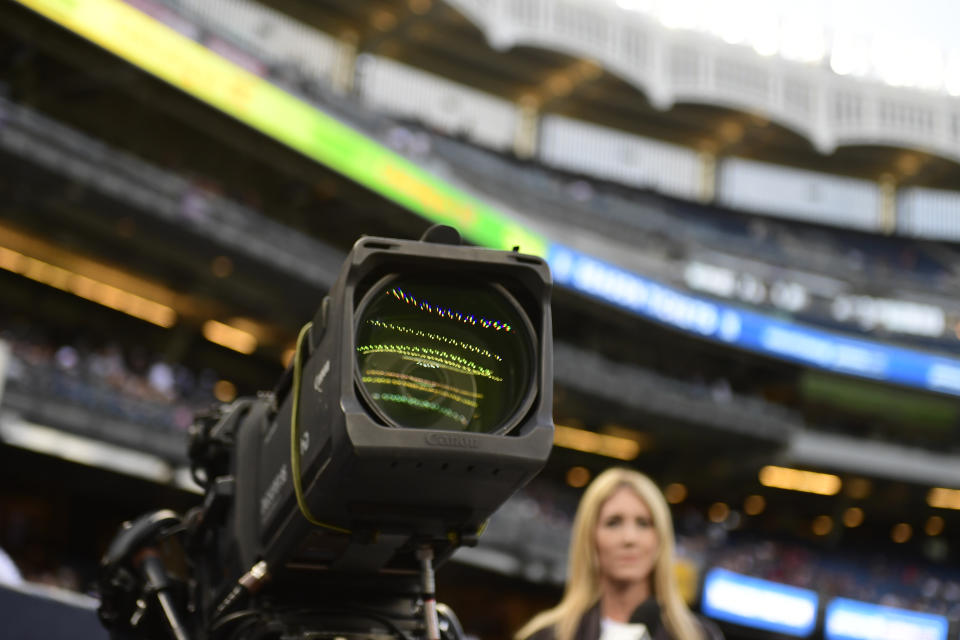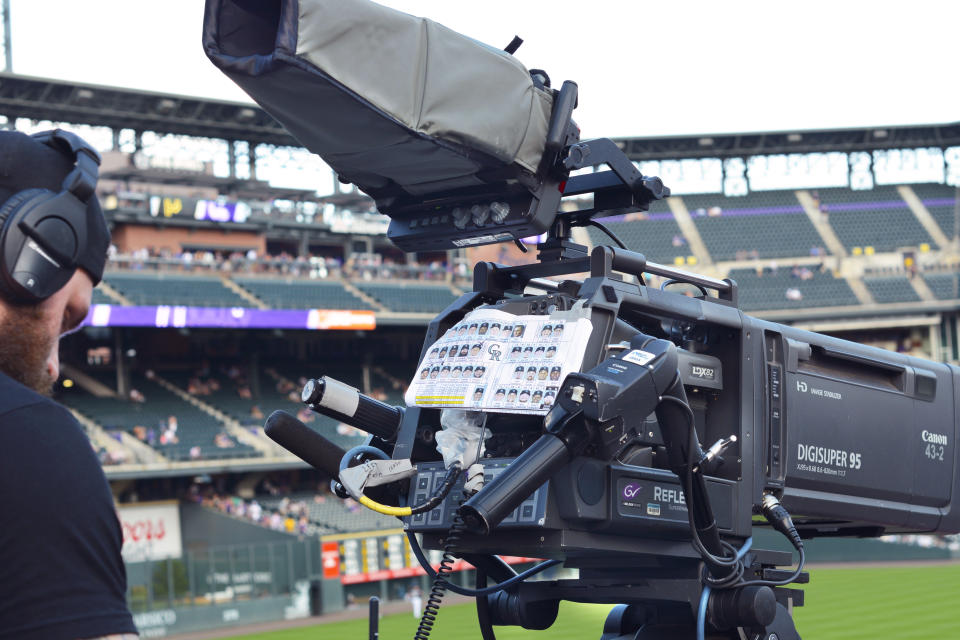The Pen: MLB owners’ vote could be big news for baseball fans cutting the cord

As part of his opening statement to reporters at Major League Baseball’s owners meetings this week, commissioner Rob Manfred said that teams had “approved unanimously a revised interactive media rights agreement.”
It was a jumbled bit of jargon that was easy to miss between the confirmation that the Kansas City Royals had a new ownership group and the part of the press conference where Manfred evaded questions about the sign-stealing investigation into the Astros organization. This winter is rife already with impactful storylines, existential threats to the game, and even some free-agent signings. It’s easy to ignore a change to the back-end business side of baseball. But this one might have direct implications for fans.
Asked to clarify what exactly the “revised interactive media rights agreement” looks like, Manfred said, “The biggest single change was the return of certain in-market digital rights — the rights that have essentially become substitutional with broadcast rights — those rights will return to the clubs.”

Yankees president Randy Levine intimated the possibility of something like that back in August when the team announced that it had reacquired the YES Network. As the Associated Press reported at the time:
Asked how the deal might affect the digital streaming rights to Yankees games within the team’s market, club president Randy Levine said he expected Major League Baseball to announce changes to its policy soon. Teams cannot currently sell digital rights to local broadcasts.
Now, apparently, they can.
I have to be perfectly honest with you: I don’t fully understand the possible range of implications here. I’m not well-versed on the broadcast business and we’re not dealing with a lot of specific information. I do, however, have hopes and fears for what this will mean for fans. Namely: how this will impact the growing number of cord-cutters’ ability to watch their local team.
MLB Advanced Media first live-streamed a baseball game in 2002 — years before even YouTube existed. The first MLB.tv packages were sold to allow fans to watch pennant races at the end of that season, and in 2003, season-long packages to watch all “out of market” games became available. Baseball’s early embrace of streaming video proved to be an almost prescient boon to the company. The back-end capabilities developed as part of MLB.tv were so sophisticated that MLB began providing streaming services for other entertainment companies like HBO and the NHL. This eventually led to the creation and sale of BAMTech, which enriched each of the team owners by some $50 million last year.
And yet, for as long as MLB.tv has been widely celebrated as “digital media's most successful live video subscription product,” fans have found themselves frustrated by the restrictions and limitations.
Annoyance with the blackouts of “local” teams — which has long existed as a way to provide expensive exclusivity to regional sports networks — manifests in two main categories of concern: being blacked out from teams that are very close by and being blacked out from teams that are very far away. The latter is certainly more egregious. Fans in Iowa and Las Vegas and Hawaii are blacked out from as many as six teams, most of whom are hundreds of miles away. But the former is perhaps more pernicious. Cord-cutters around the country can’t pay Major League Baseball to watch their hometown teams.

Because the change in policy concerns only in-market rights, the MLB.tv package will likely remain unchanged. You still can’t use it to watch the Cubs in Iowa or the Yankees in New York. However, fans without cable subscriptions will hopefully soon be able to purchase digital access to the broadcasts of their local team a la carte. The upshot for the teams is obvious — the change provides them another product to sell for profit without having to make or do anything differently — but accessibility of these digital streams to viewers will likely depend on how and to whom they’re sold.
I don’t know if (as was speculatively reported last year) teams will be able to sell these online broadcasts to Hulu or Amazon or some other existing subscription or if it’ll necessarily mean signing up for another recurring monthly cost that nearly negates not having a cable subscription in the first place. Nor do I know whether teams who own their broadcast channels (like YES) will have different avenues for distribution than those that do not.
The hope is that this will provide an easier avenue for cord-cutters to stream broadcasts of their hometown baseball team. What remains to be seen is just how much teams will prioritize maximizing this newfound revenue stream over making their product materially more accessible.
Notes from the clubhouse
Back in March, it was reported that the Blue Jays organization would be willingly paying their minor leaguers up to 50 percent more in an effort to be decent to the people who make their billion-dollar product possible. Since then we haven’t heard a ton about how that’s going so I asked GM Ross Atkins about it at the GM Meetings in Arizona last week. He said that they hadn’t been able to track a measurable benefit in on-field production but:
“You know what, it was such a gratifying thing to see the minor league players. We did not expect to get that response. At all. It just was an opportunity that presented itself and [director of baseball operations] Mike Murov and [VP of baseball operations turned Pirates GM] Ben Cherington had the idea to do and we had the room to do in our budget and we thought through what it could mean going forward and could only think of positives that could come from it. And to see the player reactions, even from players that had million dollar-plus signing bonuses, just how appreciative they were.”
Notes from the baseball internet
There is so much good baseball writing that doesn’t go dormant in the winter and maybe you missed it because you’re used to the in-season news cycle, so to help both of us (a vast collective “you” and also me) keep up with it all I’m going to spotlight some stories from around the web here at the end of some columns. This week: a whole lot of sign-stealing updates.
Whitewash: Rob Manfred says he doesn’t think sign stealing extends beyond the Astros, Craig Calcaterra at NBC Sports
While addressing reporters in Arlington, Texas, about the Astros’ recently reported sign-stealing scheme, Rob Manfred said he has “no reason to believe it extends beyond the Astros at this point in time.” The commissioner weighing in at all on the biggest story of the offseason is always newsworthy — but so is the fact that what he said is almost demonstrably untrue. Calcaterra’s column provides both the news and the context to show why it’s likely that sort of cheating extends beyond the Astros organization, and why MLB likely won’t do anything to engage with the systemic issue.
In the final public address of the owners meetings, Manfred pivoted that position a little, saying, “To the extent that we find other leads, we’re going to follow these leads.” But highlighting the absurdity of his original comments likely helped us get there.
Why Rob Manfred must make a harsh example of illegal sign-stealers (except, not that part at all), Joel Sherman at the New York Post
Buried in the fifth paragraph of this column demanding Manfred dole out “major — MAJOR — sanctions” for sign-stealing comes a very interesting detail on the precise way teams might be illegally relaying signs to the batter: “In recent days I have had scouts and executives talk to me about a variety of methods they think have been or could be employed, such as a realistic-looking electronic bandage placed on a player’s body that buzzes in real time to signal what is coming — one buzz for a fastball, for example — if the surveillance determines what type of pitching is coming.”
Hey! What! Forget the hand-wringing and give me a whole story on faux buzzing bandages that makes very clear whether we’re talking strictly hypothetically here or whether this is something actual scouts have actually seen.
Moonshot: The Astros’ Offense Took A Huge Leap After They Started Stealing Signs, Rob Arthur at Baseball Prospectus
The Astros sign-stealing scheme is, frankly, a super fun scandal in large part because it lends itself to grassroots scouring for forensic evidence, and watching that unfold has been fascinating. For example, if you haven’t spent a significant amount of time the past few weeks on Jomboy’s feed, go do so (and then read Marc Carig’s profile of the video vigilante over at The Athletic). Rob Arthur has done some pivotal audio analysis to back up the accounts originally reported in The Athletic of how the Astros relayed stolen signs, but his latest study focuses on whether it worked by tracking the team’s whiff rates before and after the audible evidence emerged that they were stealing signs. The results are satisfyingly damning.
More from Yahoo Sports:

 Yahoo Lifestyle
Yahoo Lifestyle 
